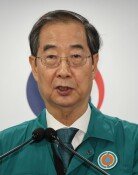Unfinished debate: verb vs. adjective
Unfinished debate: verb vs. adjective
Posted December. 18, 2017 07:57,
Updated December. 18, 2017 08:20
One of the biggest differences in the structure of English and Korean languages is the presence of a verb “be.” While it is basically used to refer to the “existence” of something, the verb “be” is also crucial in that it connects a subject and an adjective. In English, an adjective as a part of speech is not subject to change. Think about the following two sentences: “I am happy” and “I walk.” What is changing depending on the tense and person is the form of a verb, not an adjective “happy.”
On the contrary, things are different when we say “I am happy” and “I walk” in Korean because a subject, an adjective and a verb are all being directly connected in the Korean language. An adjective “happy” and a verb “walk” are to be changed according to the tense, so it is difficult to judge whether it is an adjective or a verb in a sentence structure. This is why we distinguish adjectives and verbs based on their meaning as in adjectives refer to the status of an objective while verbs refer to the motion or movement. Yet, the distinction between the two parts of speech is such a fine line, and sometimes can be simply incorrect.
Recently, the National Institute of Korean Language classified “neurkda,” which means “being or getting old” in Korean, as a verb in the Standard Korean Language Dictionary. “Neurkda” obviously indicates the status of a subject, but can be used in suggestive or imperative sentences with different endings such as “yeppeuge neurkja,” (“let us get old beautifully”) and “yeppeuge neurkeora” (“get old beautifully”). In this case, an adjective “yeppeuda” cannot work like a verb with varied endings such as “yeppeuja” or “yeppeora.” Then shouldn’t “neurkda” be classified as a verb? The institute’s classification in which “neurkda” is a verb while “jeormda,” an opposite word that means being or getting young in Korean, is an adjective is inconsistent, which should be addressed.
Also classified as verbs by the institute were “jalsaenggida” (handsome), “motsaenggida” (ugly), “jalnada” (good-looking) and “motnada” (unattractive), which all refer to the current state of a subject. They are all formed by adding adverbs “jal” (good) and “mot” (not good) to verbs “saenggida” (be created) and “nada” (happen), and should be used with the past tense form to refer to the present state. When you want to say “he is handsome” in Korean, for example, you should say that he is “jalsaenggyeotda” with an ending that signifies the past tense, not “jalsaenggida.” However, an adjective “yeppeuda” is used with a present tense to indicate the present status. Yet again, “jalsaenggida” is not used in suggestive or imperative sentences as “jalsaenggija,” (let us be handsome) or “jalsaenggyeora” (be handsome). In fact, there has been a longtime dispute over the classification of these words. Since the Korean language does not have the verb “be,” which would distinguish adjectives and verbs in a sentence, we cannot help but stumble upon such tricky words that perch on a subtle boundary.







